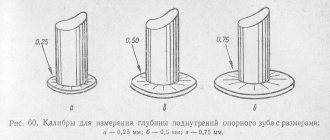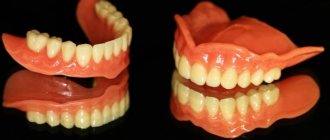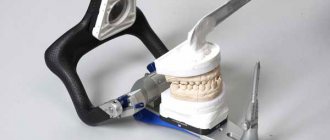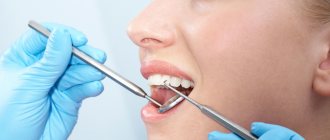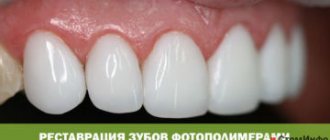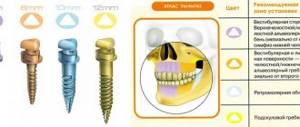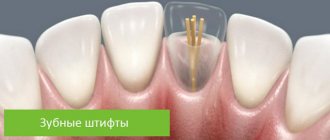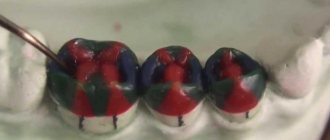Drawing up a treatment plan
You usually have to visit an orthopedist more than once. During the first consultation, the doctor examines the client’s oral cavity, determines the existing disorders and their severity. To study the location and condition of the roots, a computed tomography or radiography is performed.
The plan may include the following steps:- Choosing a method to eliminate the defect that has arisen.
- Preparation for prosthetics.
- Manufacturing and installation of prostheses.
- Assessing the dynamics of the patient's oral cavity.
Why is it important to see an orthopedist on time?
Let's not dwell on the unsightly appearance of the smile of a person who has missing teeth. Although this fact is very important. Let's talk in more detail about the problems that result from complete and partial adentia. Among them:
Difficulty chewing food. Because of this, the load on the gastrointestinal tract increases. If a patient has a predisposition to stomach diseases, they will certainly arise.- Changing the position of the “neighbors”. As soon as voids appear in a row, neighboring units try to occupy them. Because of this, the bite changes and the teeth become crooked. Such changes complicate hygiene procedures, which is fraught with caries, pulpitis, and gum inflammation. They also have a bad effect on the appearance of the smile and facial proportions.
- Atrophy of bone tissue. If teeth are missing for a long time, the jaw bone in the area where they were previously located begins to sag. This occurs due to the lack of chewing stimulation. Subsequently, atrophy causes difficulties in preparing for implantation - the patient has to undergo a complex osteoplasty operation.
Don't forget to take care of your oral health and restore missing teeth in a timely manner. However, do not give preference to the cheapest techniques. Ideally, after applying dental orthopedics, the functions of the tooth will be completely restored.
Consultation with an orthopedist at the Smile Line clinic
By undergoing treatment with our specialist in the field of orthopedic dentistry, you can install dentures and restore the integrity of the row. These concepts are not identical. The fact is that if the roots are destroyed, fixation of the crowns is impossible. Then we are no longer talking about prosthetics, but about implantation (restoration).
It is a mistake to believe that a doctor of the named specialty works only with the goal of restoring beauty to the patient’s smile. Of course, the activities he performs have a positive effect on the client’s appearance. But first of all, the specialist takes measures to restore the functionality of the jaws. They help avoid bone tissue atrophy, movement of neighboring units, and problems in the gastrointestinal tract.
When to visit a specialist
You should take advantage of the progressive possibilities of orthopedics (dentistry) in the following situations:
- the crown is very badly destroyed due to caries and it is not possible to restore it with filling material;
- the roots have completely collapsed and cannot serve as support for a future external structure;
- Dangerous pathological processes and necrosis have been identified in hard tissues;
- there are diseases that have caused a change in the shape of the crown part of the molars, incisors, and canines;
- advanced periodontal disease was detected.
Also, the help of an orthopedic dentist will be needed if there are chips, cracks, deep scratches, or individual units are positioned incorrectly in relation to their “neighbors.”
The doctor is responsible for:
- making the correct diagnosis;
- carrying out preparatory activities, preparing for planned therapy;
- choosing the optimal prosthetic method;
- installation of removable/fixed dentures.
Preparation for installation of prostheses and restorative procedures
Before installing any type of prosthesis, the doctor carries out preparatory measures. During them:
- Treats caries. All carious cavities must be closed.
- Provides therapy for detected oral diseases. It is important that the gums are in satisfactory condition and the patient is not bothered by pain.
- Eliminates anomalies. It happens that before receiving prosthetics, a person is sent for a consultation with an orthodontist so that the existing curvatures can be removed.
- Provides professional hygiene. During this procedure, it removes soft plaque and hardened stone. This measure is preventative - it eliminates gum inflammation in the future and promotes the speedy healing of implants.
- Prepares supports for crowns. To do this, the teeth are ground, treated and the canals are filled.
Only after preparation can you proceed to prosthetics and implantation.
Types of orthopedic structures
To correctly choose a prosthesis, you need to take into account a number of factors. First of all, the product must fully restore the functions of lost teeth. Also, the choice of the type of orthopedic product depends on the patient’s preferences and financial capabilities. The doctor will tell you which option to choose.
Let's figure out what types of dentures there are.
Main types:
- metal crowns;
- metal-ceramic products;
- ceramic structures.
These products are usually manufactured in two types:
- single crowns;
- bridge structures.
Determining which type of product is better is quite difficult. Each prosthesis has its own characteristics. The main differences are price and aesthetic indicators.
Among other things, dentures are divided into two types: removable and fixed. Let's take a closer look at what removable orthopedic structures are.
Popular Orthopedic Treatment Options
Each situation has its own optimal prosthetic option. There can be no universal solutions here. Orthopedic dentistry today offers many ways to treat dental disorders and anomalies.
The most popular are:
- Tabs. Replace fillings. Made from individual casts. They fill the existing carious cavity and fit tightly to its sides. They make the tooth beautiful and very durable, do not shrink over the years, and do not change the original color.
- Veneers. Overlays glued to the front surface of the crown. Requires minor preliminary grinding. They only cope with minor changes - chips, cracks, unsightly fillings, changes in the shade of enamel.
Prosthetics on implants. This type of dental orthopedics is indicated for complete or partial loss of fangs, molars, and incisors. It makes it possible to restore chewing function, eliminate problems with “lisping” diction, and make the smile area beautiful.- Crowns. Optimal if the crown part is severely destroyed and the roots are in satisfactory condition. They are made from metal, plastic, ceramics, zirconium oxide, and precious metals. The material is selected taking into account the required strength and the desired visual effect.
- Dental bridge. Used if there is no one or several adjacent units. Its edges are crowns, and the center is artificial teeth. Requires, as a minimum, two reliable supports.
- Removable structures. They can be lamellar or clasp. They are used if there is no large number of dental units. They are usually preferred by older people due to their low cost and ease of use.
Orthopedic dentistry is rightfully one of the most popular dental branches. After all, even children with primary malocclusion often become clients of an orthopedist.
